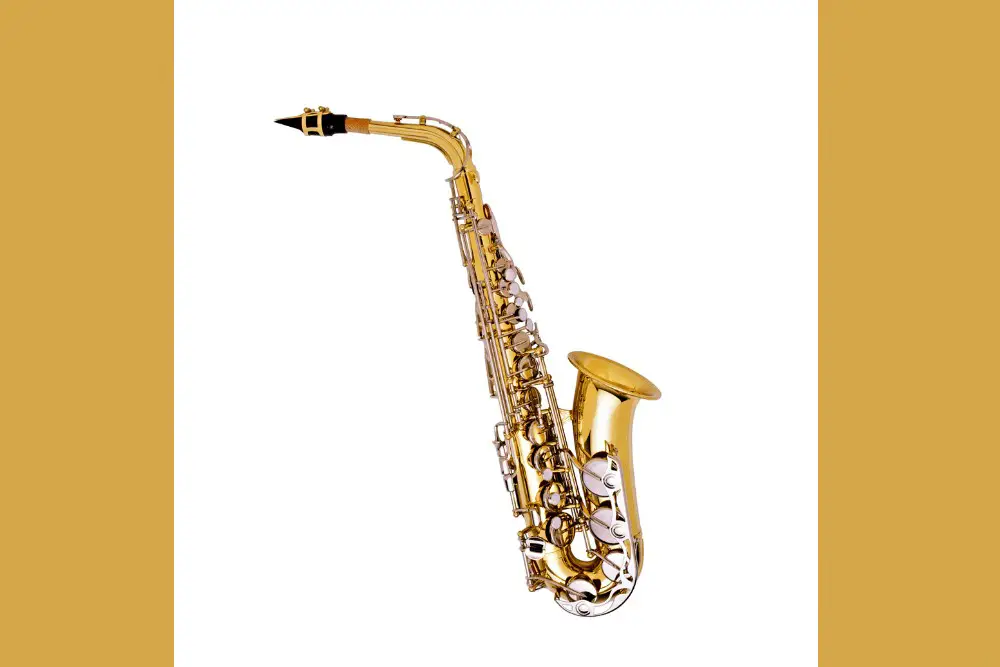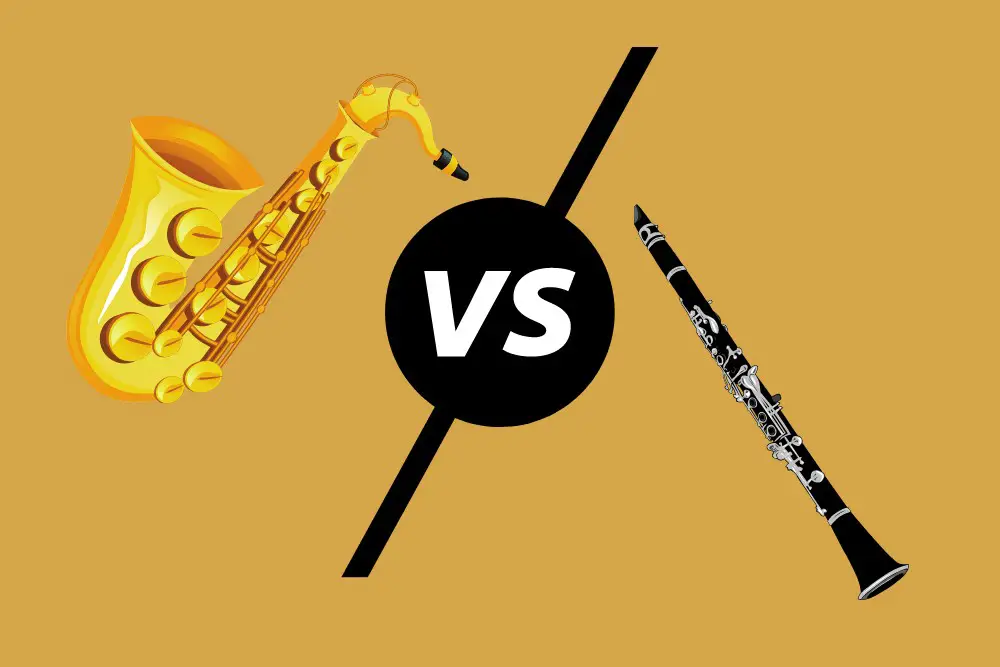Many people just love the woody, rich sounds of the woodwind family, but when it comes to picking an instrument, I see a lot of people debate if the saxophone or clarinet is better. I decided to ask my band teacher and musician friends to help me end this debate once and for all.
The saxophone and clarinet have several key similarities, including belonging to the woodwind family, changing notes by covering tone holes, difficulty level, and usage in most major ensembles. But they also have wildly different sounds, roles in groups, range, age, and design.
Let’s dig into each of these categories in this comparison to find out the main differences.
Table of Contents
Saxophone Vs. Clarinet Direct Comparison
Note: For this comparison, we’re looking at the two most common types of saxophone and clarinet: the alto sax and the Bb clarinet. This is what most people start on.
| Quality | Alto Saxophone | Clarinet in Bb |
|---|---|---|
| Instrument Family | Woodwind Family | Woodwind family |
| Sound creation | Vibrating reed on the saxophone mouthpiece | Vibrating reed on the clarinet mouthpiece |
| Where is it found? | Band, Jazz, Saxophone quartets, Popular music | Everywhere but most commonly: Band, Jazz, Orchestra |
| Voice (Range) | Alto (Db3-Ab5) | Soprano (D3-Bb6) |
| Number of Keys | Around 20 | 17 |
| Length Of Tubing | 3.9 ft (1.2 m) | 26 in (66 cm) |
| Average Cost For Intermediate Level Instrument* | $5,000 | $2,500 |
| Typical Role in Ensembles | Harmony, occasional melody | Melody or ornamentation |
| Other types of | Soprano, Alto, Tenor, Baritone | Bb Clarinet, A clarinet, Bass clarinet, Eb clarinet |
| When was it invented? | 1840s | Approximately 1700 |
| General sound description | Round, deep, strong | Rich, mellow, soothing |
| How To Change Pitch | Pressing keys covers and uncovers the tone holes changing the vibration frequency (Hz) | Pressing keys covers and uncovers the tone holes changing the vibration frequency (Hz) |
| Material | Typically brass with a lacquer protection | Typically plastic for lower-end and wood for higher-end |
What Are The Differences Between Saxophone And Clarinet?
Let’s start with the main differences between the two wind instruments.
You may also enjoy reading our saxophone vs. trumpet comparison.
Visuals/Looks
These two instruments, while sharing a lot in common, look widely different.

The saxophone is made of brass and covered in a usually yellow lacquer. It’s made of a mouthpiece, neck, and body.
The body is covered in keys (around 20) on the right side of the instrument. The saxophone neck curves around from your mouth to the body, which goes down, and then curves back up to form an elbow.
The bell points forward. If the saxophone was straightened, it would be 3.9 ft (1.2 m) in length.

A clarinet is usually black and made of plastic for cheaper options and wood for more expensive ones. It is also seen made of hard rubber.
The clarinet is made of five parts:
- Mouthpiece
- Barrel
- Upper joint
- Lower joint
- Bell
The clarinet is also covered with 17 metal keys that, when pressed, cover the tone holes spread down the middle of the upper and lower joints. It goes straight down, and the bell points down too.
This wind instrument is 26 in (66 cm) in length.
Range
The alto sax is an alto voice with a range of Db3-Ab5. The clarinet is a higher soprano voice with a range of D3-Bb6.
While they have a similar lower range, the clarinet loses a lot of its power in the lower range, known for its airy, mellow quality.
The clarinet also has a more easily accessible wide range, but the sax can play higher using the advanced altissimo technique.
The sax stays powerful throughout its whole range.
Fun Fact: The soprano saxophone has a range of Ab3-E6, putting it more in line with the clarinet.
Sound
Both instruments have an articulate yet rich tone (unlike a brass instrument which is a more rounded sound). Yet while both have a nice sound, they’re different!
Compare them yourself by listening to these two examples of professionals playing the same song.
When I hear this saxophone player, I think rich, strong, and punchy.
When I hear this clarinet player, I think pure, soaring, and mellow.
Fingering
The fingering systems are similar between the two musical instruments, but there is a key difference.
When the saxophone player hits the octave key, it jumps all the notes up an octave. The combination of saxophone fingerings concerning the notes stays almost the same.
The clarinet has a register key instead of an octave key. The lower register called the Chalumeau register after the previous version of what would become the clarinet doesn’t align with the upper register.
It’s almost like they are two clarinets!
So while the fingering may look similar in practice, they are quite different.
Role In Ensembles
The role of the two in their different groups is quite different as well.
Clarinets are focused on either the melody or ornamentation and accented the melody. When it does get the melody, it’s typically a beautiful choral line or a flying series of crazy notes.
The saxophone often gets the grand or jazzy melodies when power is needed. Outside of this, it adds to the melody.
Another part of this also revolves around the solo.
Because the clarinet sound is softer, when this wind instrument is featured, it usually features clarinet doubling, where two or three play the same feature part.
The sax has the power to project over the full band, so it can do true solos more often.
Age Of The Musical Instruments
Both instruments have been around for a while (though nowhere as long as the flute).
It’s unclear when the clarinet came into being, but the year 1700 AD is a good estimate. Over time, we’ve landed on these as the most common members of the clarinet family:
- Bb Clarinet (also known as the soprano clarinet)
- A clarinet
- Bass clarinet
- Eb clarinet
- Contrabass clarinet (rare)
Adolphe Sax invented the sax in 1840, and he envisioned 7 types of saxophones in two different keys, one for a band and one for orchestra.
Here is the saxophone family:
- Contrabass
- Bass
- Baritone*
- Tenor*
- Alto*
- Soprano Sax*
- Sopranino
*These are the four most common ones in use today.
Saxophone And Clarinet Similarities
For all their difference, they are the same or similar in several key areas. In my experience, most people will some sax skill play the clarinet well and vice versa.
Instrument Family
Both instruments are in the same family of instruments. They are both aerophones or wind instruments because they use air to create their sound.
Digger down more specifically, they are in the same smaller family of woodwind instruments. This family is defined by blowing air to split (as with flute) or using a reed (as with our two we’re looking at today) to create the vibrations.
The saxophone reed and the clarinet reed are pretty similar in size and shape too.
The common members of the woodwind family are:
- Flute
- Clarinet
- Saxophone
- Oboe*
- English horn*
- Bassoon*
*These are double-reed instruments; they use two reeds instead of a single reed.
For this reason, they even have a similar lip shape when playing. It’s not the same, but it’s pretty close, especially compared to a brass instrument like the french horn.
The sax player and clarinet player both use their lips tightly wrapped around the end of the mouthpiece and reed.
The saxophone embouchure is usually a little higher because of the angle the mouthpiece comes in at.
Since the other points more downward, the clarinet embouchure is close to the chin and a tighter embouchure.
How To Change Notes
The fingering itself doesn’t match up as well, but the method of changing the notes is the same.
Both of these musical instruments are covered in explicitly designed and measure tone holes. There are more holes than fingers, so they both use keys which, when pressed, cover specific holes.
As the holes are covered, the length of the sound waves grows due to the longer or more air space in the instrument. This lowers and changed the pitch.
Oppositely, uncovering tone holes raise the speed of sound and pitch.
As a general rule, to play higher, the clarinet and saxophone use a key on the back of their instrument to open up an extra tone hole toward the instrument’s top to grab notes in a higher register or octave.
Usage
Both are found in most types of ensembles, including:
- Concert band
- Marching band
- Small groups
- Orchestral music
- Jazz band
- Popular music
These are two of the most common instruments played in school bands.
However, due to the younger age of the saxophone, it hasn’t gained as much footing in an orchestra. It’s rarely used in classical music, though it is possible.
On the other hand, the clarinet isn’t in as much popular music as it was in the 1960s and before. It’s not unheard of, but not as common as the sax.
Both are equally common in jazz music, though the sax has a stronger public perception.
Care
The care of these instruments is essentially the same. With sax, there’s more instrument to clean, but both will have no major problems with daily cleanings.
Check out our guide on how to clean a saxophone.
Should I Play Saxophone Or Clarinet?
Both of these are close in difficulty level; they make great beginner instruments.
It depends on two factors:
- Which are you more interested in?
- Which is easier for you to make a sound on?
The saxophone has easier fingerings to remember and makes a sound a little easier. On the other hand, it’s larger and requires more air.
Much sax sheet music is also more modern, often calling on advanced techniques when you reach higher levels of play. Most people won’t have to worry about this, though.
The clarinet is easier to handle, requires less air, and has more traditional techniques (though they often get to a point where they play blindingly fast!).
On the other hand, the fingerings are a little more complex, and I’ve noticed many students struggled a tiny bit more to make their sound.
If you already have access to one of these instruments, you may want to consider saving money and just using the one your cousin, family member, or friend has.
By the same token, if you’re strapped for cash, the clarinet is cheaper on average though it’s possible to find both at similar price points.
Other than these factors, it’s up to you. I’d err on the side of interest; pick the one you like more.
You may also enjoy reading these:
FAQ
Is saxophone easier than clarinet? – The difficulty level of the instruments is essentially the same.
What is the main difference between saxophone and clarinet? – The biggest difference between the two instruments is their size and range.
Is clarinet quieter than saxophone? – While both instruments may play soft, the clarinet is the overall quieter instrument.

